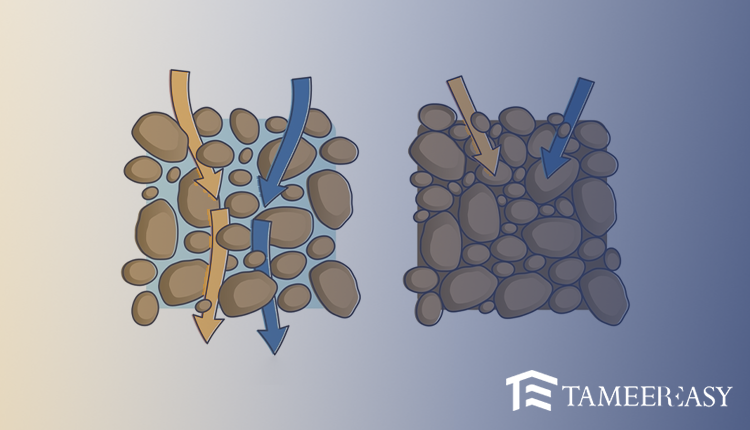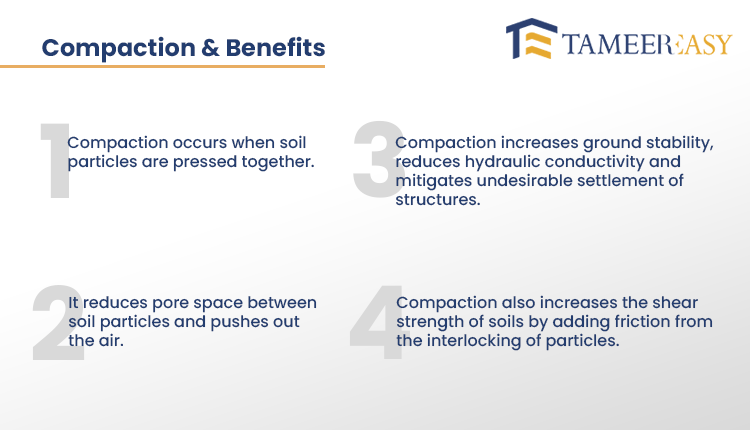House building is something which has immense importance for people all over the globe. A huge majority put their whole life’s earnings into house making, and it automatically becomes quite crucial for them to build a house that can last longer and does not suffer any kind of disastrous issue. Civil structures are vulnerable to many issues, particularly cracks and floor settlement which can even lead to the collapse of the whole building. One of the optimal solutions to avoid this issue is soil compaction, which provides a strong base to the overall structure and prevents cracks or fissures in the building.
Visit TameerEasy Store to Purchase Quality Construction Items
If you want to get all details about the compaction, what is it, and why it is necessary before starting a building, you have landed on the right page. This article covers all the important aspects of soil compaction. You can scroll down the page to update yourself about this critical construction process.

What is Compaction?
It is a well-established fact that civil structures are built on foundations. The soil under them always has gaps that eventually disturb the overall building. Filling all those gaps between the soil particles is crucial so the foundation can smoothly rest on it. Soil compaction is a process that is carried out to bring all those particles together. It ultimately results in the hardening of the ground providing a firm base for the building.
Maybe you have seen road rollers working on the roads; they are used to compact the roads because roads have to bear huge burdens and could not afford scattered soil particles under them. There are a large number of compactor machines as well. They are used for this purpose, especially in areas where soil under the surface is weak.
Importance of Soil Compaction
While erecting any civil structure, soil compaction plays an important role in the following ways:
- It is imperative for any building to have a flat base underneath it, and soil compaction is the best way to achieve this.
- It increases the overall strength of the soil, ultimately leading to strong buildings.
- Soil compaction lessens the void ratio between the solid particles in the form of empty spaces or filled with fluid.
- The risks of floor settlement are mitigated.
- Soil compaction combines all the soil particles providing power to the surface, ultimately increasing its weight-bearing capacity.
How Soil Compaction is Performed?
Now we are coming to another important question ‘How to compact soil?.’ There are a variety of methods to carry out soil compaction, which are as follows:
- Manual rodding is the most common method in which a rod of around 2 meters compacts the soil. They are normally used in the construction of small civil structures like houses.
- The second most popular method is using fuel or electricity-supported compactor machines easily available in the market. They are also available for rent which you can hire for a few hours or days to carry out the soil compaction.
Key Points to Consider While Carrying Out Compaction
- The excavation and foundation must be smooth so that the compaction can achieve maximum results.
- The targeted area should be cleared of any grass or vegetation.
- Water should be sprinkled in the specific area to make the soil a little moist but in a controlled quantity, as too much water can create mud.
- Excavation at the targeted place should be done till the hard surface.
- Always make sure to avoid loose fills and muddy areas before making foundations.


Benefits of Soil Compaction to Buildings
Understanding the benefits of soil compaction is a bit technical, but let us make it easy for you.
The load of any building is distributed through the roof to the walls, from where it comes to the foundation. So if the compaction is good, it can withstand the overall load effectively. A strong compacted surface strengthens the structure, making it stand long.
Drawbacks of not Having Compaction
- No compaction can lead to the bad distribution of load resulting in cracks on the walls and roofs.
- Water supply and sewerage pipes can get leaked due to cracks on the surface.
- Poor soil grading or compaction can even lead to cracks on the floor. It can ultimately result in tilt in the building, even causing one of the sides to collapse.
How to Check the Soil Compaction
Various soil compaction testing methods using a nuclear meter or a sand cone are usually carried out at big projects, particularly buildings, transmission lines, etc. Normally during the construction of houses, you can check the compaction by walking on the surface, and if you can see your footprints, it means that the compaction is not good enough. Moreover, you can also examine the soil compaction by pushing your shoes’ heels on the surface.
Closing Remarks
So in this article, we have briefly explained the compaction process. You can get an idea of how this little-looking task is crucial for the overall life of any building. Many structures collapse because the builders do not pay much attention to compaction while making the foundation. So if you want more construction-related work, contact our experts by visiting our website, tameereasy.com.







